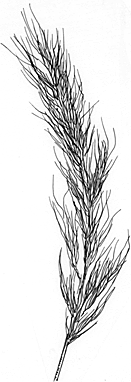Common Name: Plumegrasses

Description: Tufted annuals or perennials.
Leaves with ligule membranous; blade flat or convolute, usually scabrous, often pubescent.
Inflorescence a dense spike-like or loose to open panicle.
Spikelets solitary, pedicellate, narrow, numerous and overlapping on the short branches, disarticulating above the glumes; one bisexual floret, rachilla usually not produced as a bristle. Glumes subequal or unequal, narrow, subulate, keeled on the single, scabrous nerve. Lemma shorter than the glumes, firm, entire or 2-fid, faintly nerved, awned from below the apex, the awn slender, curved or bent, column usually twisted; callus hairy. Palea narrow, slightly shorter than the lemma. Stamens 1–3.
Distribution and occurrence: World: c. 10 species, Australia, New Zealand, Pacific islands. Australia: c. 9 species (native), all States except N.T.
A genus of c. 10 species fron Australasia. Cool seeason grasses with rough leaves and are common and probably useful components of natural pasture. Dichelachne species are cool-season grasses and are common and probably useful components of natural pasture. The stems of D. crinita have been used to make paper.
Text by S. W. L. Jacobs & K. L. McClay
Taxon concept:
| | Key to the species | |
| 1 | Awns 2.5 cm long or longer and 4–6 times as long as their lemmas; panicle dense and spike-like with no branching visible and awns usually concealing the spikelets | Dichelachne crinita |
| Awns 0.8–3.3 cm long and 2–5 times as long as their lemmas; panicle dense or open | 2 |
| 2 | Lemma usually < 4 mm long | 3 |
| Lemma 4 mm or longer
Back to 1 | 5 |
| 3 | Lemma longer than at least the lower glume; inflorescence sparse, with branches and pedicles clearly visible, only slightly contracted at anthesis; branches flexuose | Dichelachne parva |
| Lemma usually shorter than glumes; inflorescence dense with spikelets and awns concealing the branches; branches not flexuose
Back to 2 | 4 |
| 4 | Awn 10–22 mm long; usually 1 anther | Dichelachne micrantha |
| Awn < 10 mm long; anthers 3
Back to 3 | Dichelachne montana |
| 5 | Lemma usually at least 6 mm long, hispid pubescent; plants often hairy | Dichelachne hirtella |
| Lemma mostly less than 6 mm long, hispid, scabrous or glabrous; plants sometimes hairy
Back to 2 | 6 |
| 6 | Lemma subequal to lower glume | Dichelachne rara |
| Lemma longer than lower glume, sometimes longer than both glumes
Back to 5 | 7 |
| 7 | Culms and nodes hairy or scabrous to pubescent; lemma usually scabrous; awn column slightly twisted at maturity | Dichelachne sieberiana |
| Culms and nodes glabrous; lemma mostly smooth, sometimes scabrous; awn colume only slightly twisted at maturity
Back to 6 | 8 |
| 8 | Palea 4 mm long or less; awn arising 0.5 mm or less from lemma apex; inflorescence < 24 cm long | Dichelachne inaequiglumis |
| Palea > 4 mm long; awn arising 0.5 mm or more from lemma apex; inflorescence > 24 cm long
Back to 7 | Dichelachne robusta |
|


